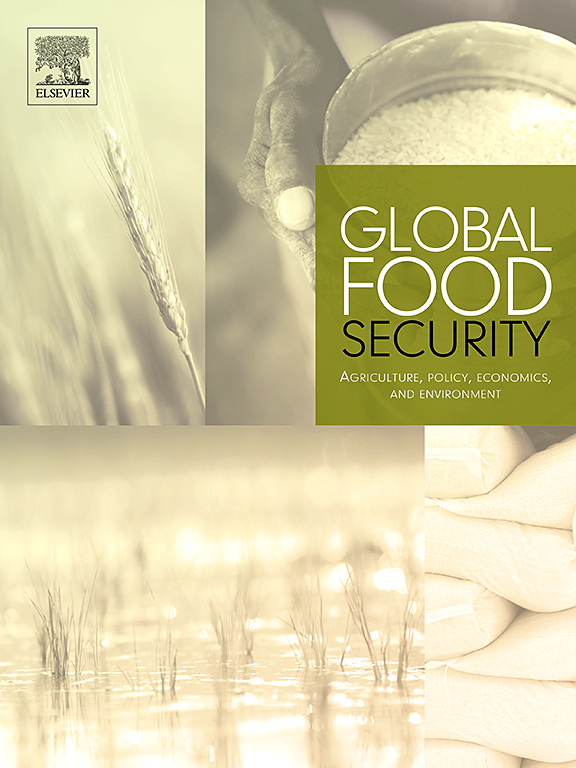Nutrient production, water consumption, and stresses of large-scale versus small-scale agriculture: A global comparative analysis based on a gridded crop model
IF 9.6
1区 经济学
Q1 FOOD SCIENCE & TECHNOLOGY
Global Food Security-Agriculture Policy Economics and Environment
Pub Date : 2025-03-13
DOI:10.1016/j.gfs.2025.100844
引用次数: 0
Abstract
Agricultural water consumption is the main contributor to water scarcity worldwide, while small-scale and large-scale agriculture have distinguishing characteristics. Significant gaps remain in the process-based agricultural production and water consumption estimates distinguishing small-scale and large-scale agriculture, which inhibits our deep understanding of where, how, and by whom crops are produced and against what water outcomes. We close this gap by leveraging a gridded crop model, covering 61% of the global harvested area using a 2010 baseline. Results show small-scale agriculture accounts for 43% of the total harvested area, however, contributes to relatively less nutrient production despite cultivating more food crops (relative to their total harvested area) than large-scale agriculture. This result challenges the assumption made by existing global scale studies when allocating national agricultural production to small-scale and large-scale agriculture, which (partly) ignores the differences in climate conditions, soil characteristics, input level, and type of irrigation that small-scale versus large-scale agriculture may have. The lower contribution is due to both water and soil fertility stress. Small-scale agriculture overrepresents in water-scarce regions but consumes much less blue water (38%) compared to its harvested area (54%). In water-scarce regions, soil fertility stress causes small-scale agriculture the unproductive green water utilization and a 70–90% unmet crop production potential. Our findings demonstrate the unequal exposure and contribution to water scarcity between small-scale and large-scale agriculture and between food and non-food crops. Understanding such disparities is one of the first and necessary steps toward enhancing the resilience and sustainability of agricultural systems.
大规模与小规模农业的养分生产、水消耗和压力:基于网格作物模型的全球比较分析
农业用水是世界范围内水资源短缺的主要原因,而小规模农业和大规模农业各有特点。在区分小规模和大规模农业的基于过程的农业生产和用水量估计方面仍然存在重大差距,这阻碍了我们对在哪里、如何、由谁生产作物以及对水资源产生何种影响的深刻理解。我们利用网格作物模型缩小了这一差距,该模型使用2010年基线覆盖了全球收获面积的61%。结果表明,小规模农业占总收获面积的43%,然而,尽管种植了更多的粮食作物(相对于其总收获面积),但与大规模农业相比,小规模农业对养分生产的贡献相对较少。这一结果挑战了现有全球规模研究在将国家农业生产分配给小规模和大规模农业时所做的假设,这些假设(部分)忽略了小规模和大规模农业在气候条件、土壤特征、投入水平和灌溉类型方面可能存在的差异。较低的贡献是由于水和土壤肥力胁迫。小规模农业在缺水地区的比例过高,但与收获面积(54%)相比,其消耗的蓝水(38%)要少得多。在缺水地区,土壤肥力压力导致小规模农业绿水利用效率低下,作物生产潜力70-90%未得到满足。我们的研究结果表明,小规模农业和大规模农业以及粮食作物和非粮食作物之间对水资源短缺的暴露和贡献是不平等的。了解这种差异是提高农业系统复原力和可持续性的首要和必要步骤之一。
本文章由计算机程序翻译,如有差异,请以英文原文为准。
求助全文
约1分钟内获得全文
求助全文
来源期刊

Global Food Security-Agriculture Policy Economics and Environment
FOOD SCIENCE & TECHNOLOGY-
CiteScore
20.90
自引率
3.40%
发文量
69
期刊介绍:
Global Food Security plays a vital role in addressing food security challenges from local to global levels. To secure food systems, it emphasizes multifaceted actions considering technological, biophysical, institutional, economic, social, and political factors. The goal is to foster food systems that meet nutritional needs, preserve the environment, support livelihoods, tackle climate change, and diminish inequalities. This journal serves as a platform for researchers, policymakers, and practitioners to access and engage with recent, diverse research and perspectives on achieving sustainable food security globally. It aspires to be an internationally recognized resource presenting cutting-edge insights in an accessible manner to a broad audience.
 求助内容:
求助内容: 应助结果提醒方式:
应助结果提醒方式:


